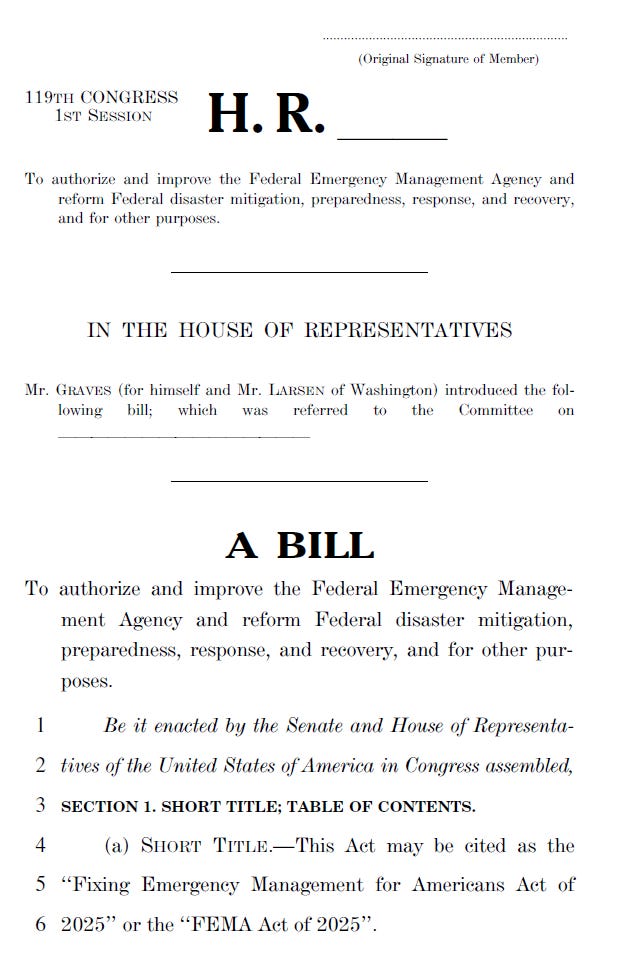Read With Me: The FEMA Act of 2025
Part I: Background and Division A (Establishment of FEMA as a Cabinet-Level Independent Agency)
Since being elected, President Trump and his administration have been flirting with the idea of eliminating or dramatically downsizing the size and scope of FEMA. The President has empaneled a council to advise him on reforming the agency, and a significant number of career professionals have left as part of the DOGE-fueled buyouts and voluntary early retirement program. A lot of digital ink has been spilled assessing the potential changes at FEMA, including by our team at the Urban Institute (see pieces here, here and here).
All this time, a bi-partisan group of House members has been working in the background to draft legislation that would also significantly reform FEMA, albeit in a different direction. A few months after releasing draft legislation, the leadership of the House Transportation and Infrastructure Committee (Sam Graves R-MO; Rick Larsen D-WA) and Subcommittee on Economic Development, Public Buildings and Emergency Management (Daniel Webster R-FL; and Greg Stanton D-AZ) introduced the Fixing Emergency Management for Americans Act of 2025 (H.R. 4669), or FEMA Act of 2025.
The bill comes after months of behind-the-scenes work by staff from the T&I committee (full disclosure, we met with the bi-partisan staff to discuss research evidence on key topics at their request and in keeping with our research principles of non-partisanship) to listen and learn from stakeholders at all levels. I’ve read the discussion draft of the bill but am beginning my full read-through of the introduced legislation, and thought I would invite you along.
I’ll be splitting this post into several installments and plan to keep things at a fairly high level…there are LOTS of small details in the bill that I am not going to touch on, partly for brevity and partly because I am not an expert on them. For those topics I’ll be looking to my erudite colleagues or readers for explanation.
Division A: Establishment of FEMA as a Cabinet-Level Independent Agency
The bill starts off with a bang, calling for FEMA to be (re)established as a cabinet-level agency. A short history lesson, for those who may need a refresher…FEMA was originally created as an independent federal agency under President Carter, with the Director answering to the president. In 2003, with the passage of the Homeland Security Act, FEMA was absorbed into the Department of Homeland Security and its Director (now called Administrator) began reporting to the head of DHS instead. There is a lot written about this period between 9/11 and Hurricane Katrina that I won’t rehash here…suffice it to say that the sudden focus on domestic and international terrorism and the building up of the domestic security state did not work to the benefit of FEMA’s core focus on natural and manmade disasters. After the agency’s abysmal response to Hurricane Katrina, Congress partly restored the independent function of FEMA as part of the Post-Katrina Emergency Management Reform Act, which gave the Administrator direct access to the president during major disasters, among other important changes. Nonetheless, close watchers of FEMA have long been calling for the organization to be restored to a cabinet-level agency. There are many arguments in-favor of the move, from rebuilding FEMA’s culture around its humanitarian mission to improving bureaucratic efficiency. There have been numerous efforts over the years to pass legislation to this effect, including a recent bill introduced by Senators Thom Tillis (R-NC) and Alex Padilla (D-CA).
A few additional notes:
The bill maintains the requirement that FEMA’s presidentially-appointed leader have a “demonstrated ability in, and knowledge of, emergency management” and “not less than 5 years of executive leadership and management experience in the public or private sector.” Aka the “Brownie did not do a heck of a job” rule.
Many of the features and functions of FEMA as we know it (or knew it, depending on who you ask) are transferred to this new cabinet-level agency…a focus on an all-hazards strategy, the presence of the National Advisory Council, and the functions described by the Stafford Act, National Flood Insurance Act, National Dam Safety Act, etc.
The bill would restore FEMA’s Office of Inspector General, which had been absorbed into the OIG for DHS.
The change would need to happen within 1 year of the passage of the bill.
Next up, Public Assistance. Stay tuned.



Thank you, Andrew, I want to hear what you have to say... you are one of my trusted sources!!! Hope you are doing well.
Mary Schoenfeldt